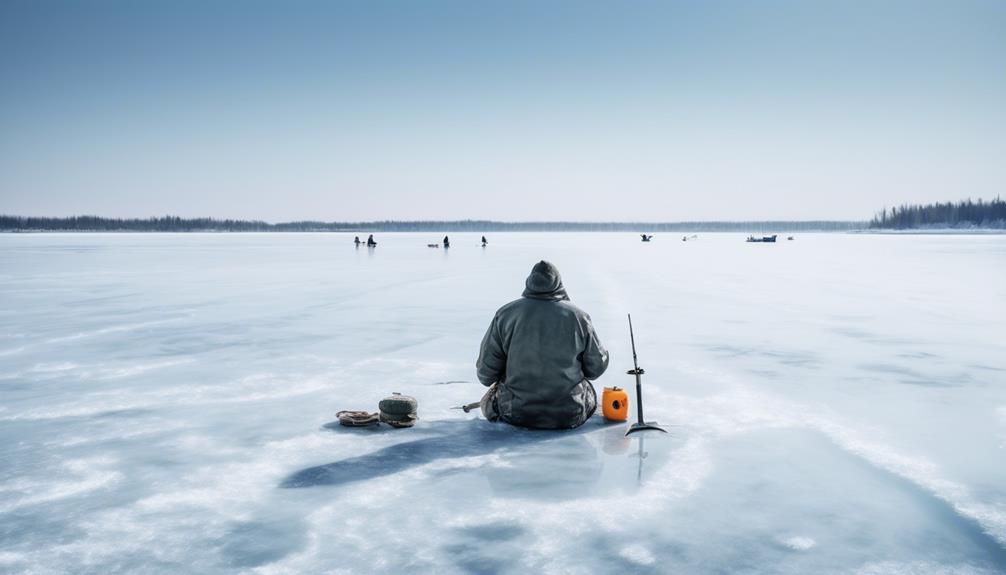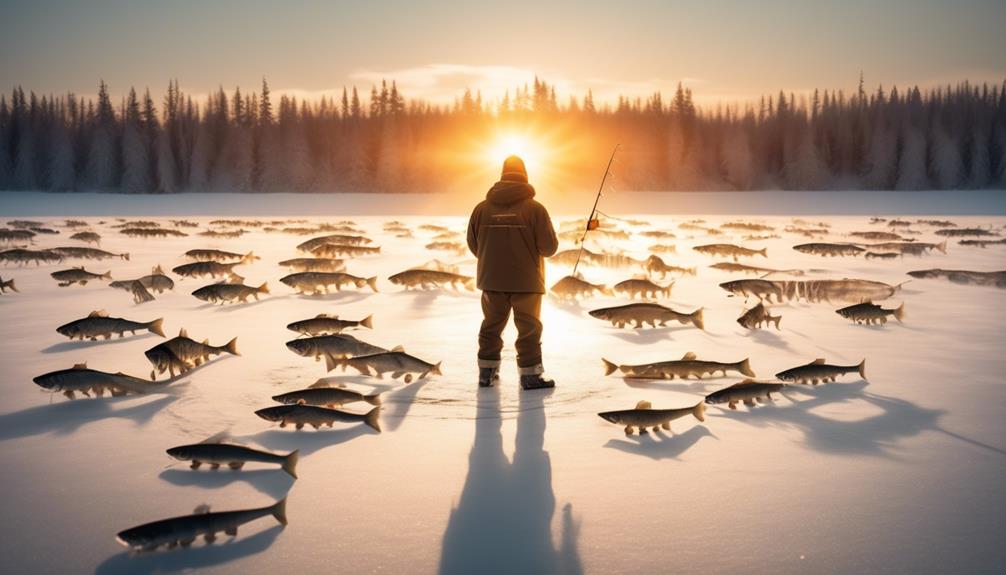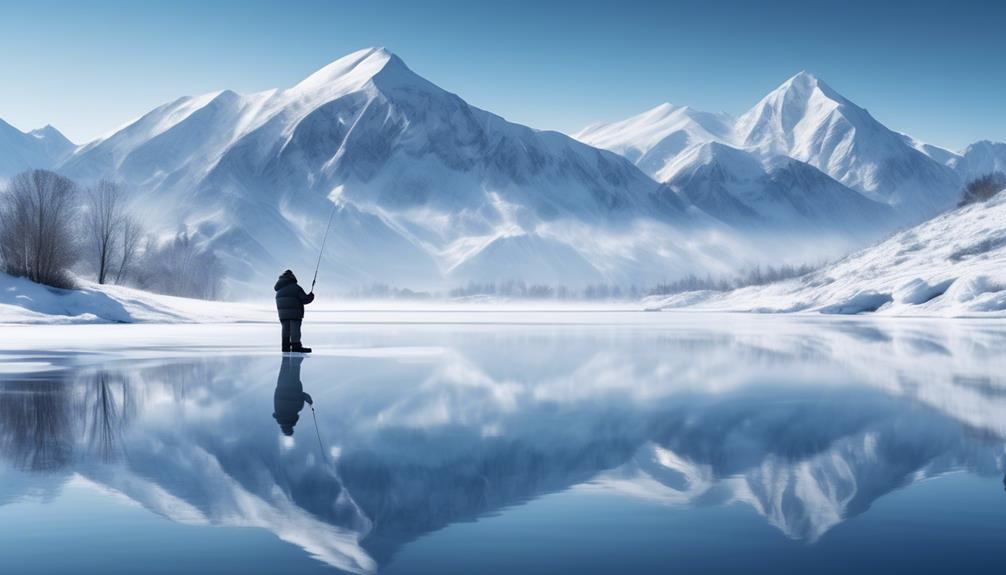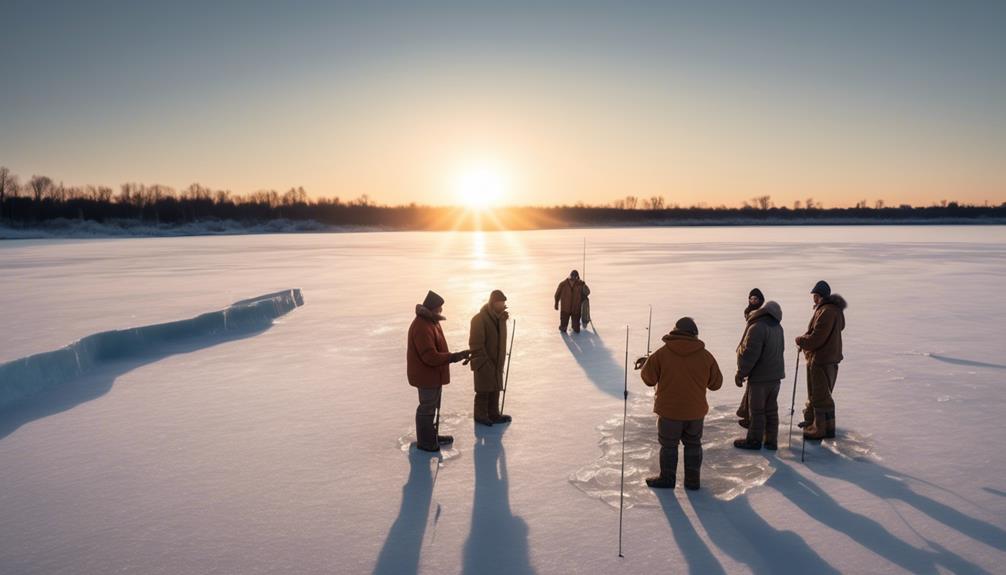Have you ever wondered why some anglers seem to effortlessly hook trophy-sized fish while ice fishing?
The secret lies in a combination of skill, strategy, and understanding of the unique challenges presented by ice fishing.
From mastering the behavior of trophy fish to employing effective bait and lure strategies, there are numerous factors that contribute to success on the ice.
But what sets these exceptional anglers apart?
Stay tuned to uncover the key elements that elevate certain ice anglers to trophy-catching status.
Understanding the Behavior of Trophy Fish
Understanding the behavior of trophy fish is essential for increasing your chances of a successful catch. Fish psychology plays a crucial role in ice fishing, and gaining insight into trophy fish habits can significantly improve your angling success. Trophy fish, such as northern pike and walleye, exhibit distinct behavioral patterns that can be leveraged to optimize your fishing strategy.
Trophy fish are often apex predators in their habitats, and they display territorial behavior, particularly during the spawning season. Knowing this, you can target these areas and adjust your bait presentation to trigger a territorial response. Understanding their feeding habits is also critical. Trophy fish are opportunistic feeders, but they can be selective in their prey choices. By studying their diet and the availability of forage in the area, you can tailor your bait selection to match their preferences, increasing the likelihood of a strike.
Moreover, trophy fish are sensitive to changes in light and weather conditions. They tend to be more active during low light periods, such as dawn and dusk, or under overcast skies. By timing your fishing trips to coincide with these periods, you can capitalize on their heightened feeding activity.
Mastering Ice Fishing Techniques
To improve your ice fishing success, mastering a variety of techniques is crucial for adapting to changing conditions and increasing your chances of a rewarding catch. Here are some essential ice fishing tips to help you become a proficient angler and understand fish behavior:
- Jigging: Master the art of jigging by experimenting with different jigging motions and speeds. Varying your jigging technique can entice finicky fish to strike, especially when they're exhibiting cautious behavior.
- Tip-ups: Learn to set up and manage tip-ups effectively. Understanding the behavior of fish species in your chosen fishing spot will help you position your tip-ups strategically, increasing your chances of a successful catch.
- Hole hopping: Embrace the practice of hole hopping to explore different fishing locations. Fish behavior can change throughout the day, so being willing to move around and experiment with new spots can lead to more opportunities to catch trophy fish.
- Using electronics: Familiarize yourself with using fish finders and underwater cameras to gain insights into fish behavior and locate their whereabouts. This can be particularly beneficial when targeting elusive trophy fish, as it allows you to adapt your techniques based on real-time observations.
Utilizing the Right Equipment and Gear
Equipping yourself with the right ice fishing gear is essential for maximizing your chances of a successful and enjoyable fishing experience. When it comes to proper clothing, layering is key. Start with a moisture-wicking base layer to keep sweat away from your skin, followed by an insulating layer to retain body heat, and finish with a waterproof and windproof outer layer to protect against the elements. It's critical to wear waterproof and insulated boots to keep your feet warm and dry throughout the day. Don't forget to bring along a warm hat, gloves, and a neck gaiter to shield exposed skin from the biting cold.
In addition to proper clothing, safety precautions shouldn't be overlooked. One of the most important safety measures is to ensure the ice is thick enough to support your weight. Always carry ice picks, a rope, and a personal flotation device in case of an emergency. It's also crucial to have a set of ice cleats to provide traction on slippery surfaces. Furthermore, a portable ice shelter can offer protection from extreme weather conditions and serve as a refuge if the weather takes a turn for the worse.
Identifying Prime Ice Fishing Locations
When it comes to ice fishing, knowing how to identify prime fishing locations can significantly impact your chances of catching trophy fish. Here are some tips to help you scout out the best spots:
- Seek Out Ice Fishing Hotspots: Research and talk to local anglers to identify popular ice fishing hotspots. These areas are often frequented by fish and can increase your chances of a successful catch.
- Utilize Effective Scouting Techniques: Invest time in scouting the ice before setting up. Look for signs of fish activity such as underwater vegetation, structures, or even the presence of other anglers. This can help you pinpoint potential hotspots.
- Consider Environmental Factors: Pay attention to environmental factors such as water depth, underwater features, and current patterns. These can influence fish behavior and help you identify prime locations for ice fishing.
- Understand Fish Migration Patterns: Research the typical migration patterns of the fish species you're targeting. Understanding where the fish are likely to be during different times of the year can guide you to prime ice fishing locations.
Adapting to Changing Weather Conditions
Adapting to changing weather conditions requires staying vigilant and adjusting your ice fishing strategies accordingly. When the weather shifts, it's crucial to have a plan to ensure a successful ice fishing trip.
One essential element of adapting to changing weather conditions is the use of an ice shelter. These shelters provide protection from harsh winds, snow, and extreme cold, allowing you to remain comfortable and focused on fishing. Additionally, ice shelters offer a controlled environment, making it easier to adapt to fluctuating weather patterns. They provide a stable base for your ice fishing endeavors, regardless of the weather outside.
Temperature control is another vital aspect of adjusting to changing weather conditions. As temperatures rise or fall, your approach to ice fishing must also adapt. In warmer conditions, it's essential to manage the temperature inside your ice shelter to prevent the ice from melting too quickly. This might involve using ventilation to allow heat to escape or even utilizing portable fans to circulate air.
Conversely, in frigid conditions, ensuring that your ice shelter retains heat becomes crucial. Utilizing insulation and portable heaters can help maintain a comfortable and safe environment within the shelter.
Employing Effective Bait and Lure Strategies
To improve your chances of catching trophy fish while ice fishing, employ effective bait and lure strategies that will entice the fish to bite. When it comes to bait selection and presentation, consider the following:
- Understand the Fish's Preferences: Research the specific fish species you're targeting to determine their preferred bait. Some fish are attracted to live bait such as minnows or worms, while others may respond better to artificial bait like jigs or spoons.
- Adjust Your Presentation: Experiment with different bait presentations to see what works best. This could involve varying the depth at which the bait is presented, using a bobber to suspend the bait at a certain level, or adding movement to the bait to make it more appealing.
Moving on to lure movement and timing, keep the following in mind:
- Vary Your Lure Movement: Change the speed and rhythm of your lure's movement to mimic the behavior of natural prey. Sometimes a slow and subtle movement can be more enticing, while other times a faster, erratic motion may trigger a strike.
- Consider the Timing: Pay attention to the time of day and the behavior of the fish. Some species are more active during dawn and dusk, while others may be more likely to strike during the middle of the day. Adjust your lure movement and presentation based on the fish's activity levels.
Patience and Persistence in Ice Fishing

If you want to excel in ice fishing, patience and persistence are the keys to success. Mental preparation and focus are crucial when it comes to waiting for that trophy fish to bite.
Ice fishing requires a great deal of patience, as you may have to wait for extended periods in the cold, but the rewards can be well worth it. It's essential to stay focused on the task at hand and maintain a positive mindset, even when the fish aren't biting.
Strategic planning and preparation are also vital in ice fishing. Before heading out onto the ice, it's important to have a plan in place. This includes researching the best locations, understanding the behavior of the fish you're targeting, and being prepared with the right equipment. By strategically planning your ice fishing trip, you can maximize your chances of success and ensure that you're fully prepared for the conditions you'll encounter.
Once you're out on the ice, persistence is key. It's not uncommon to experience periods of inactivity where the fish simply aren't biting. However, it's important to persist and continue trying different techniques and adjusting your approach. Trophy fish are often elusive, and it's those who persist through the challenging times that are most likely to be rewarded with a successful catch.
Learning From Experienced Ice Anglers
As you pursue mastery in ice fishing, gleaning valuable insights from experienced anglers who've honed their craft can significantly enhance your skills and success on the ice. Learning from those who've spent years perfecting their ice fishing techniques can provide you with invaluable knowledge and guidance. Here's how you can benefit from engaging with experienced ice anglers:
- Mentorship Opportunities: Engaging with experienced ice anglers provides you with mentorship opportunities that can significantly accelerate your learning curve. A mentor can offer personalized guidance, share their experiences, and provide you with tips and tricks that they've learned over the years.
- Skill Development: Experienced anglers can help you develop and refine essential ice fishing skills such as jigging techniques, reading underwater topography, and understanding fish behavior in cold water. By learning from their expertise, you can improve your abilities and become a more effective angler.
- Access to Specialized Knowledge: Engaging with seasoned ice anglers gives you access to specialized knowledge about particular fishing spots, ice conditions, and the habits of local fish species. This insider information can be crucial for improving your catch rates and overall success on the ice.
- Networking Opportunities: Building relationships with experienced ice anglers can expand your network within the ice fishing community. This can lead to new fishing opportunities, access to exclusive information, and the chance to learn from a diverse range of perspectives and experiences.
Engaging with experienced ice anglers can be a game-changer in your pursuit of ice fishing mastery.
Frequently Asked Questions
How Can Anglers Improve Their Ability to Understand the Behavior of Trophy Fish in Different Ice Fishing Conditions?
To understand the behavior of trophy fish in different ice fishing conditions, focus on behavior analysis. Improve your fishing techniques by studying fish movements and habits in various ice fishing conditions.
What Are Some Advanced Ice Fishing Techniques That Experienced Anglers Use to Consistently Catch Trophy Fish?
To catch trophy fish while ice fishing, you'll need to master advanced techniques. Utilize underwater cameras to locate fish and employ stealth techniques to ensure they don't detect your presence, increasing your chances of success.
Are There Specific Types of Equipment and Gear That Are Not Commonly Used in Ice Fishing but Can Greatly Increase the Chances of Catching Trophy Fish?
To increase your chances of catching trophy fish while ice fishing, consider using customized rigs and innovative electronics. These tools can give you an edge and help you excel in catching those elusive big ones.
How Do Anglers Identify Prime Ice Fishing Locations That Are Less Known or Not Frequently Mentioned in Traditional Ice Fishing Guides?
To find prime ice fishing spots, trust local knowledge and look for natural signs like underwater structures and changes in ice color or thickness. Talk to experienced anglers and explore lesser-known areas for hidden gems.
Are There Any Unconventional Bait and Lure Strategies That Have Been Proven to Be Highly Effective in Catching Trophy Fish While Ice Fishing?
When ice fishing, unconventional bait and lure strategies can be highly effective in catching trophy fish. Understanding ice fishing conditions and trophy fish behavior is key. Experiment with different techniques to find what works best for you.
Conclusion
So, if you want to excel at catching trophy fish while ice fishing, it's important to understand the behavior of the fish. Mastering ice fishing techniques is crucial, as well as using the right equipment and gear. Identifying prime fishing locations is essential, as is adapting to changing weather conditions. Employing effective bait and lure strategies can greatly increase your chances of success. Additionally, having patience and persistence is key. Learning from experienced ice anglers can provide valuable insights and tips to help you improve your ice fishing skills. Keep practicing and honing your skills, and you'll be catching trophy fish in no time!



